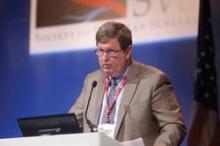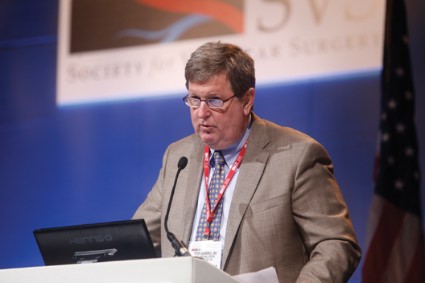User login
BOSTON – This year’s F. Stanley Crawford Critical Issues Forum, titled "Appropriate Use of Vascular Surgery Procedures: Do We Have a Problem?," was a response to the question of whether vascular surgeons are performing too many procedures and if enough evidence exists to support the ones that are being done, according to Dr. Peter F. Lawrence, incoming president of the SVS. Dr. Lawrence, who organized this year’s session, discussed how the issue of overuse and appropriateness has become a common theme in the media, in public policy discussions, and among medical societies.
"In Vascular Specialist, our newspaper, both Drs. Frank Veith and Russell Samson have written editorials about the overuse of vascular procedures. Dr. Veith titled his topic ‘The Blacksnake Phenomenon’ and pointed out that not everything that we find and identify needs to be treated."
Dr. Lawrence chose and introduced five speakers charged with addressing the problem.
Dr. Robert M. Zwolak addressed the currently available data on vascular surgery procedures, focusing in particular on the Medicare procedural data derived from the Centers for Medicare & Medicaid Services. He pointed out several instances where the number of vascular procedures performed decreased tremendously over time, independent of reimbursement, including a remarkable 47% decrease in major amputations from 1996 to 2013. Open lower extremity bypass decreased, by 57%, to such a low level that it called into question the ability of the specialty to maintain excellence in performing the procedure. On the flip side, there was also a tremendous increase in certain procedures, including vein treatments, which grew more than 6,000% when reimbursement became available.
Dr. Michael D. Dake addressed the critical issue of optimizing multispecialty involvement in vascular procedures. In particular, he advocated a cooperative vs. adversarial approach. This included working together for common credentialing, institutional harmonization, and development of "care teams" for vascular diseases, such as already exist for transcatheter aortic valve replacement. He said SVS should take responsibility for promoting a "Big Tent approach" and become the overarching society dealing with all things vascular, including involvement in common credentialing and guidelines development.
Dr. Timothy Ferris discussed the various types of influence that hospital and physician practice organizations could have that impact appropriateness. In particular, he outlined a computer program that his own institution, Massachusetts General Hospital, Boston, developed that allows physicians to recognize and comply with guideline criteria generated through multispecialty consensus at the hospital. Within a few years, they found a tremendous increase in the number of procedures deemed appropriate. This information enabled them to influence insurance providers to waive the necessity of preauthorization, which often requires up to 30 people to fill out the paperwork.
Dr. Peter Gloviczki addressed the issue of practice guidelines as criteria for determining appropriateness. He reiterated their importance, but maintained that they were highly variable in their evidentiary basis, and that the quality of individual guidelines should always be considered so as to avoid a "herd mentality."
Dr. Samson topped off the forum with a discussion of the ethical issues related to frequency of procedures. He pointed out that personal integrity is critical and that the greatest potential risk of unethical behavior exists in outpatient centers. "The only time an intervention occurs is when a major complication sends a patient to a hospital or a negligent action results in a malpractice suit. As long as our government and insurers fail to determine what and where and who should be doing these procedures, I believe we will have unscrupulous doctors let loose on their unsuspecting prey." He said one of the ways to prevent this was to require that only board-certified and appropriately trained physicians be allowed to perform procedures.
BOSTON – This year’s F. Stanley Crawford Critical Issues Forum, titled "Appropriate Use of Vascular Surgery Procedures: Do We Have a Problem?," was a response to the question of whether vascular surgeons are performing too many procedures and if enough evidence exists to support the ones that are being done, according to Dr. Peter F. Lawrence, incoming president of the SVS. Dr. Lawrence, who organized this year’s session, discussed how the issue of overuse and appropriateness has become a common theme in the media, in public policy discussions, and among medical societies.
"In Vascular Specialist, our newspaper, both Drs. Frank Veith and Russell Samson have written editorials about the overuse of vascular procedures. Dr. Veith titled his topic ‘The Blacksnake Phenomenon’ and pointed out that not everything that we find and identify needs to be treated."
Dr. Lawrence chose and introduced five speakers charged with addressing the problem.
Dr. Robert M. Zwolak addressed the currently available data on vascular surgery procedures, focusing in particular on the Medicare procedural data derived from the Centers for Medicare & Medicaid Services. He pointed out several instances where the number of vascular procedures performed decreased tremendously over time, independent of reimbursement, including a remarkable 47% decrease in major amputations from 1996 to 2013. Open lower extremity bypass decreased, by 57%, to such a low level that it called into question the ability of the specialty to maintain excellence in performing the procedure. On the flip side, there was also a tremendous increase in certain procedures, including vein treatments, which grew more than 6,000% when reimbursement became available.
Dr. Michael D. Dake addressed the critical issue of optimizing multispecialty involvement in vascular procedures. In particular, he advocated a cooperative vs. adversarial approach. This included working together for common credentialing, institutional harmonization, and development of "care teams" for vascular diseases, such as already exist for transcatheter aortic valve replacement. He said SVS should take responsibility for promoting a "Big Tent approach" and become the overarching society dealing with all things vascular, including involvement in common credentialing and guidelines development.
Dr. Timothy Ferris discussed the various types of influence that hospital and physician practice organizations could have that impact appropriateness. In particular, he outlined a computer program that his own institution, Massachusetts General Hospital, Boston, developed that allows physicians to recognize and comply with guideline criteria generated through multispecialty consensus at the hospital. Within a few years, they found a tremendous increase in the number of procedures deemed appropriate. This information enabled them to influence insurance providers to waive the necessity of preauthorization, which often requires up to 30 people to fill out the paperwork.
Dr. Peter Gloviczki addressed the issue of practice guidelines as criteria for determining appropriateness. He reiterated their importance, but maintained that they were highly variable in their evidentiary basis, and that the quality of individual guidelines should always be considered so as to avoid a "herd mentality."
Dr. Samson topped off the forum with a discussion of the ethical issues related to frequency of procedures. He pointed out that personal integrity is critical and that the greatest potential risk of unethical behavior exists in outpatient centers. "The only time an intervention occurs is when a major complication sends a patient to a hospital or a negligent action results in a malpractice suit. As long as our government and insurers fail to determine what and where and who should be doing these procedures, I believe we will have unscrupulous doctors let loose on their unsuspecting prey." He said one of the ways to prevent this was to require that only board-certified and appropriately trained physicians be allowed to perform procedures.
BOSTON – This year’s F. Stanley Crawford Critical Issues Forum, titled "Appropriate Use of Vascular Surgery Procedures: Do We Have a Problem?," was a response to the question of whether vascular surgeons are performing too many procedures and if enough evidence exists to support the ones that are being done, according to Dr. Peter F. Lawrence, incoming president of the SVS. Dr. Lawrence, who organized this year’s session, discussed how the issue of overuse and appropriateness has become a common theme in the media, in public policy discussions, and among medical societies.
"In Vascular Specialist, our newspaper, both Drs. Frank Veith and Russell Samson have written editorials about the overuse of vascular procedures. Dr. Veith titled his topic ‘The Blacksnake Phenomenon’ and pointed out that not everything that we find and identify needs to be treated."
Dr. Lawrence chose and introduced five speakers charged with addressing the problem.
Dr. Robert M. Zwolak addressed the currently available data on vascular surgery procedures, focusing in particular on the Medicare procedural data derived from the Centers for Medicare & Medicaid Services. He pointed out several instances where the number of vascular procedures performed decreased tremendously over time, independent of reimbursement, including a remarkable 47% decrease in major amputations from 1996 to 2013. Open lower extremity bypass decreased, by 57%, to such a low level that it called into question the ability of the specialty to maintain excellence in performing the procedure. On the flip side, there was also a tremendous increase in certain procedures, including vein treatments, which grew more than 6,000% when reimbursement became available.
Dr. Michael D. Dake addressed the critical issue of optimizing multispecialty involvement in vascular procedures. In particular, he advocated a cooperative vs. adversarial approach. This included working together for common credentialing, institutional harmonization, and development of "care teams" for vascular diseases, such as already exist for transcatheter aortic valve replacement. He said SVS should take responsibility for promoting a "Big Tent approach" and become the overarching society dealing with all things vascular, including involvement in common credentialing and guidelines development.
Dr. Timothy Ferris discussed the various types of influence that hospital and physician practice organizations could have that impact appropriateness. In particular, he outlined a computer program that his own institution, Massachusetts General Hospital, Boston, developed that allows physicians to recognize and comply with guideline criteria generated through multispecialty consensus at the hospital. Within a few years, they found a tremendous increase in the number of procedures deemed appropriate. This information enabled them to influence insurance providers to waive the necessity of preauthorization, which often requires up to 30 people to fill out the paperwork.
Dr. Peter Gloviczki addressed the issue of practice guidelines as criteria for determining appropriateness. He reiterated their importance, but maintained that they were highly variable in their evidentiary basis, and that the quality of individual guidelines should always be considered so as to avoid a "herd mentality."
Dr. Samson topped off the forum with a discussion of the ethical issues related to frequency of procedures. He pointed out that personal integrity is critical and that the greatest potential risk of unethical behavior exists in outpatient centers. "The only time an intervention occurs is when a major complication sends a patient to a hospital or a negligent action results in a malpractice suit. As long as our government and insurers fail to determine what and where and who should be doing these procedures, I believe we will have unscrupulous doctors let loose on their unsuspecting prey." He said one of the ways to prevent this was to require that only board-certified and appropriately trained physicians be allowed to perform procedures.

